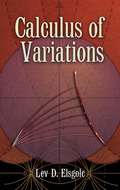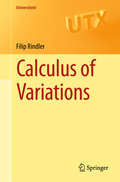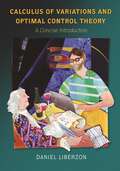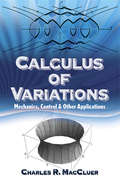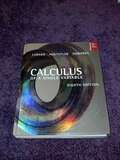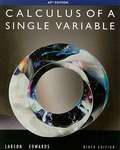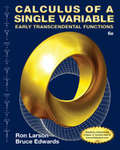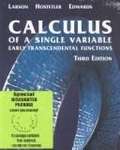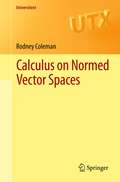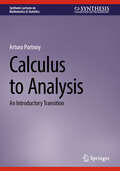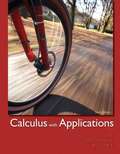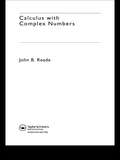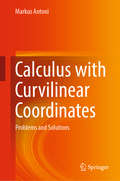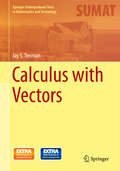- Table View
- List View
Calculus of Variations
by Lev D. ElsgolcThis concise text offers both professionals and students an introduction to the fundamentals and standard methods of the calculus of variations. In addition to surveys of problems with fixed and movable boundaries, it explores highly practical direct methods for the solution of variational problems.Topics include the method of variation in problems with fixed boundaries; variational problems with movable boundaries and other problems; sufficiency conditions for an extremum; variational problems of constrained extrema; and direct methods of solving variational problems. Each chapter features numerous illustrative problems, and solutions appear at the end.
Calculus of Variations (Dover Books on Mathematics)
by S. V. Fomin I. M. GelfandBased on a series of lectures given by I. M. Gelfand at Moscow State University, this book actually goes considerably beyond the material presented in the lectures. The aim is to give a treatment of the elements of the calculus of variations in a form both easily understandable and sufficiently modern. Considerable attention is devoted to physical applications of variational methods, e.g., canonical equations, variational principles of mechanics, and conservation laws.The reader who merely wishes to become familiar with the most basic concepts and methods of the calculus of variations need only study the first chapter. Students wishing a more extensive treatment, however, will find the first six chapters comprise a complete university-level course in the subject, including the theory of fields and sufficient conditions for weak and strong extrema. Chapter 7 considers the application of variational methods to the study of systems with infinite degrees of freedom, and Chapter 8 deals with direct methods in the calculus of variations. The problems following each chapter were made specially for this English-language edition, and many of them comment further on corresponding parts of the text. Two appendices and suggestions for supplementary reading round out the text.Substantially revised and corrected by the translator, this inexpensive new edition will be welcomed by advanced undergraduate and graduate students of mathematics and physics.
Calculus of Variations (Dover Books on Mathematics)
by Robert WeinstockThis book by Robert Weinstock was written to fill the need for a basic introduction to the calculus of variations. Simply and easily written, with an emphasis on the applications of this calculus, it has long been a standard reference of physicists, engineers, and applied mathematicians. The author begins slowly, introducing the reader to the calculus of variations, and supplying lists of essential formulae and derivations. Later chapters cover isoperimetric problems, geometrical optics, Fermat's principle, dynamics of particles, the Sturm-Liouville eigenvalue-eigenfunction problem, the theory of elasticity, quantum mechanics, and electrostatics. Each chapter ends with a series of exercises which should prove very useful in determining whether the material in that chapter has been thoroughly grasped.The clarity of exposition makes this book easily accessible to anyone who has mastered first-year calculus with some exposure to ordinary differential equations. Physicists and engineers who find variational methods evasive at times will find this book particularly helpful. "I regard this as a very useful book which I shall refer to frequently in the future." J. L. Synge, Bulletin of the American Mathematical Society.
Calculus of Variations (Universitext)
by Filip RindlerThis textbook provides a comprehensive introduction to the classical and modern calculus of variations, serving as a useful reference to advanced undergraduate and graduate students as well as researchers in the field. Starting from ten motivational examples, the book begins with the most important aspects of the classical theory, including the Direct Method, the Euler-Lagrange equation, Lagrange multipliers, Noether’s Theorem and some regularity theory. Based on the efficient Young measure approach, the author then discusses the vectorial theory of integral functionals, including quasiconvexity, polyconvexity, and relaxation. In the second part, more recent material such as rigidity in differential inclusions, microstructure, convex integration, singularities in measures, functionals defined on functions of bounded variation (BV), and Γ-convergence for phase transitions and homogenization are explored. While predominantly designed as a textbook for lecture courses on the calculus of variations, this book can also serve as the basis for a reading seminar or as a companion for self-study. The reader is assumed to be familiar with basic vector analysis, functional analysis, Sobolev spaces, and measure theory, though most of the preliminaries are also recalled in the appendix.
Calculus of Variations and Optimal Control Theory: A Concise Introduction
by Daniel LiberzonThis textbook offers a concise yet rigorous introduction to calculus of variations and optimal control theory, and is a self-contained resource for graduate students in engineering, applied mathematics, and related subjects. Designed specifically for a one-semester course, the book begins with calculus of variations, preparing the ground for optimal control. It then gives a complete proof of the maximum principle and covers key topics such as the Hamilton-Jacobi-Bellman theory of dynamic programming and linear-quadratic optimal control. Calculus of Variations and Optimal Control Theory also traces the historical development of the subject and features numerous exercises, notes and references at the end of each chapter, and suggestions for further study. Offers a concise yet rigorous introduction Requires limited background in control theory or advanced mathematics Provides a complete proof of the maximum principle Uses consistent notation in the exposition of classical and modern topics Traces the historical development of the subject Solutions manual (available only to teachers) Leading universities that have adopted this book include: University of Illinois at Urbana-Champaign ECE 553: Optimum Control Systems Georgia Institute of Technology ECE 6553: Optimal Control and Optimization University of Pennsylvania ESE 680: Optimal Control Theory University of Notre Dame EE 60565: Optimal Control
Calculus of Variations on Fibred Manifolds and Variational Physics: A Geometrical Approach to Variational Problems in Physics (Lecture Notes in Physics #1033)
by Jana Musilová Pavla Musilová Olga RossiThis book presents modern variational calculus in mechanics and field theories with applications to theoretical physics. It is based on modern mathematical tools, specifically fibred spaces and their jet prolongations, which operate with vector fields and differential forms on foundational structures. The book systematically explains Lagrangian and Hamiltonian mechanics and field theory, with a focused exploration of the underlying structures. Additionally, it addresses the well-known inverse problem of calculus of variations and provides examples illustrating key variational physical theories. The text is complemented by solved examples from physics and includes exercises designed to help readers master the subject. Aimed at PhD students, postdocs, and interested researchers, this book assumes prior knowledge of mathematical analysis, linear and multilinear algebra, as well as elements of general and theoretical physics for effective engagement with the discussion.
Calculus of Variations: Mechanics, Control and Other Applications
by Charles R. MaccluerThe first truly up-to-date treatment of the calculus of variations, this text is also the first to offer a simple introduction to such key concepts as optimal control and linear-quadratic control design. Suitable for junior/senior-level students of math, science, and engineering, this volume also serves as a useful reference for engineers, chemists, and forest/environmental managers. Its broad perspective features numerous exercises, hints, outlines, and comments, plus several appendixes, including a practical discussion of MATLAB.Students will appreciate the text's reader-friendly style, which features gradual advancements in difficulty and starts by developing technique rather than focusing on technical details. The examples and exercises offer many citations of engineering-based applications, and the exercises range from elementary to graduate-level projects, including longer projects and those related to classic papers.
Calculus of a Single Variable
by Ron Larson Bruce H. Edwards Robert P. HostetlerIdeal for the single-variable, one-, or two-semester calculus course, Calculus of a Single Variable, 8/e, contains the first 9 chapters of Calculus, 8/e. The text continues to offer instructors and students new and innovative teaching and learning resources. The Calculus series was the first to use computer-generated graphics, to include exercises involving the use of computers and graphing calculators, to be available in an interactive CD-ROM format, to be offered as a complete, online calculus course, and to offer a two-semester Calculus I with Precalculus text. Every edition of the series has made the mastery of traditional calculus skills a priority, while embracing the best features of new technology and, when appropriate, calculus reform ideas. Now, the Eighth Edition is the first calculus program to offer algorithmic homework and testing created in Maple so that answers can be evaluated with complete mathematical accuracy. Two primary objectives guided the authors in writing this book: to develop precise, readable materials for students that clearly define and demonstrate concepts and rules of calculus and to design comprehensive teaching resources for instructors that employ proven pedagogical techniques and saves the instructor time. The Eighth Edition continues to provide an evolving range of conceptual, technological, and creative tools that enable instructors to teach the way they want to teach and students to learn they way they learn best.
Calculus of a Single Variable
by Bruce H. Edwards Robert P. HostetlerCalculus Of A Single Variable For Advanced High School Students, 8th Edition Student Edition
Calculus of a Single Variable (7th Edition)
by Ron Larson Bruce H. Edwards Robert P. HostellerThis Seventh Edition continues to offer instructors and students a text that is pedagogically sound, mathematically precise, and comprehensible. There are many minor changes in the mathematics, prose, art, and design. Significant new feature is Problem Solving. In each chapter, a two-page collection of new applied and theoretical exercises is included. These exercises offer problems that have some unusual characteristics that set them apart from exercises in a regular exercise set.
Calculus of a Single Variable, AP*Edition
by Ron Larson Bruce EdwardsThe Larson CALCULUS program has a long history of innovation in the calculus market. It has been widely praised by a generation of students and professors for its solid and effective pedagogy that addresses the needs of a broad range of teaching and learning styles and environments. Each title is just one component in a comprehensive calculus course program that carefully integrates and coordinates print media and technology products for successful teaching and learning.
Calculus of a Single Variable: AP Edition (Ninth Edition)
by Ron Larson Bruce H. Edwards Robert P. HostetlerThe Larson CALCULUS program has a long history of innovation in the calculus market. It has been widely praised by a generation of students and professors for its solid and effective pedagogy that addresses the needs of a broad range of teaching and learning styles and environments. Each title is just one component in a comprehensive calculus course program that carefully integrates and coordinates print, media, and technology products for successful teaching and learning.
Calculus of a Single Variable: Early Transcendental Functions
by Ron Larson Robert Hostetler Bruce H. EdwardsDesigned for the first two semesters of a three-semester engineering calculus course, Calculus of a Single Variable: Early Transcendental Functions, 4/e, continues to offer instructors and students innovative teaching and learning resources. Two primary objectives guided the authors in the revision of this book: to develop precise, readable materials for students that clearly define and demonstrate concepts and rules of calculus; and to design comprehensive teaching resources for instructors that employ proven pedagogical techniques and save time. The Larson/Hostetler/Edwards Calculus program offers a solution to address the needs of any calculus course and any level of calculus student. Calculus of a Single Variable: Early Transcendental Functions, 4/e, contains Chapters 1-10 of the full Calculus: Early Transcendental Functions, 4/e, text. Every edition from the first to the fourth of Calculus: Early Transcendental Function, 4/e, has made the mastery of traditional calculus skills a priority, while embracing the best features of new technology and, when appropriate, calculus reform ideas. Now, the Fourth Edition is part of the first calculus program to offer algorithmic homework and testing created in Maple so that answers can be evaluated with complete mathematical accuracy.
Calculus of a Single Variable: Early Transcendental Functions (6th Edition)
by Ron Larson Bruce EdwardsCalculus of a Single Variable: Early Transcendental Functions, Sixth Edition, offers students innovative learning resources. Every edition from the first to the sixth of Calculus: Early Transcendental Functions has made the mastery of traditional calculus skills a priority, while embracing the best features of new technology and, when appropriate, calculus reform ideas.
Calculus of a Single Variable: Early Transcendental Functions (Third Edition)
by Ron Larson Bruce H. Edwards Robert P. HostetlerThe Third Edition offers instructors and students a text that is pedagogically sound, mathematically precise, and comprehensible. There are many minor changes in the mathematics, prose, art, and design.
Calculus on Normed Vector Spaces (Universitext)
by Rodney ColemanThis book serves as an introduction to calculus on normed vector spaces at a higher undergraduate or beginning graduate level. The prerequisites include basic calculus and linear algebra, as well as a certain mathematical maturity. All the important topology and functional analysis topics are introduced where necessary. In its attempt to show how calculus on normed vector spaces extends the basic calculus of functions of several variables, this book is one of the few textbooks to bridge the gap between the available elementary texts and high level texts. The inclusion of many non-trivial applications of the theory and interesting exercises provides motivation for the reader.
Calculus to Analysis: An Introductory Transition (Synthesis Lectures on Mathematics & Statistics)
by Arturo PortnoyThis book addresses the analysis of functions of a real variable and transitions from the standard calculus sequence to mathematical analysis. The author presents the limits and convergence of sequences of functions, illustrates the limitations of the Riemann integral, and discusses the need for a new integral: the Lebesgue integral. The fundamental concepts of the theory of calculus of one variable is presented in addition to limits, continuity, derivatives and its applications, and integrals and their applications. The tone and language of the book is kept as informal as possible along with the descriptions and examples to aid learning. The book is concise and presents single variable advanced calculus leading up to Fourier analysis. In addition, the book sets up sufficient background for a course in measure theory and Lebesgue integration.
Calculus with Analytic Geometry (Advanced Placement, 8th Edition)
by Ron Larson Bruce H. Edwards Robert P. HostetlerCalculus, Eighth Edition, offers comprehensive coverage of the material required by students in a three-semester or four-quarter calculus course, including carefully stated theories and proofs.
Calculus with Analytic Geometry (Seventh Edition)
by Ron Larson Bruce H. Edwards Robert P. HostellerThis Seventh Edition continues to offer instructors and students a text that is pedagogically sound, mathematically precise, and comprehensible.
Calculus with Applications (10th Edition)
by Margaret L. Lial Raymond N. Greenwell Nathan P. RitcheyCalculus with Applications, Tenth Edition by Lial, Greenwell, and Ritchey, is our most applied text to date, making the math relevant and accessible for students of business, life science, and social sciences. Current applications, many using real data, are incorporated in numerous forms throughout the book, preparing students for success in their professional careers. With this edition, students will find new ways to get involved with the material, such as "Your Turn" exercises and "Apply It" vignettes that encourage active participation.
Calculus with Complex Numbers
by John B. ReadeThis practical treatment explains the applications complex calculus without requiring the rigor of a real analysis background. The author explores algebraic and geometric aspects of complex numbers, differentiation, contour integration, finite and infinite real integrals, summation of series, and the fundamental theorem of algebra. The Residue Theo
Calculus with Curvilinear Coordinates: Problems and Solutions
by Markus AntoniThis book presents problems and solutions in calculus with curvilinear coordinates. Vector analysis can be performed in different coordinate systems, an optimal system considers the symmetry of the problem in order to reduce calculatory difficulty. The book presents the material in arbitrary orthogonal coordinates, and includes the discussion of parametrization methods as well as topics such as potential theory and integral theorems. The target audience primarily comprises university teachers in engineering mathematics, but the book may also be beneficial for advanced undergraduate and graduate students alike.
Calculus with Vectors (Springer Undergraduate Texts in Mathematics and Technology)
by Jay S. TreimanCalculus with Vectors grew out of a strong need for a beginning calculus textbook for undergraduates who intend to pursue careers in STEM fields. The approach introduces vector-valued functions from the start, emphasizing the connections between one-variable and multi-variable calculus. The text includes early vectors and early transcendentals and includes a rigorous but informal approach to vectors. Examples and focused applications are well presented along with an abundance of motivating exercises. The approaches taken to topics such as the derivation of the derivatives of sine and cosine, the approach to limits and the use of "tables" of integration have been modified from the standards seen in other textbooks in order to maximize the ease with which students may comprehend the material. Additionally, the material presented is intentionally non-specific to any software or hardware platform in order to accommodate the wide variety and rapid evolution of tools used. Technology is referenced in the text and is required for a good number of problems.
